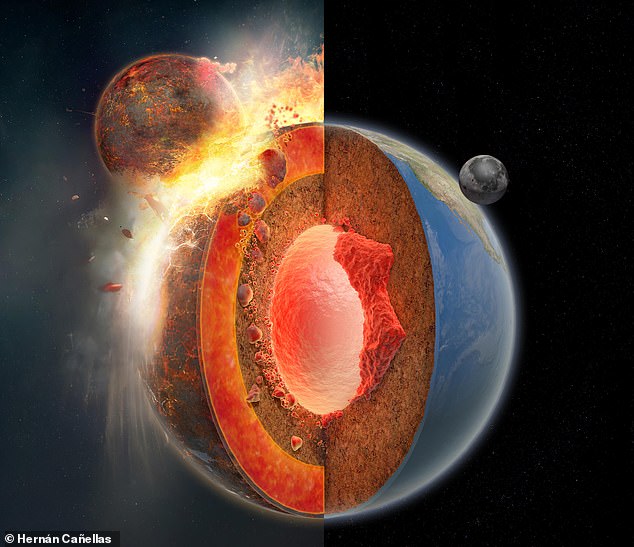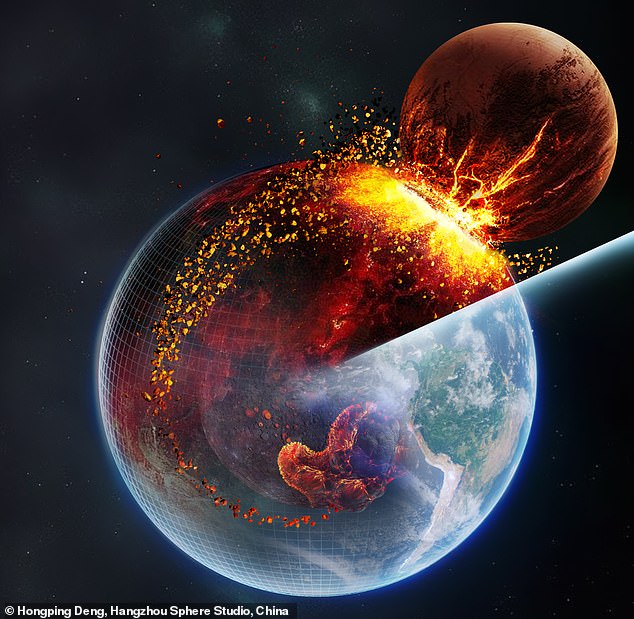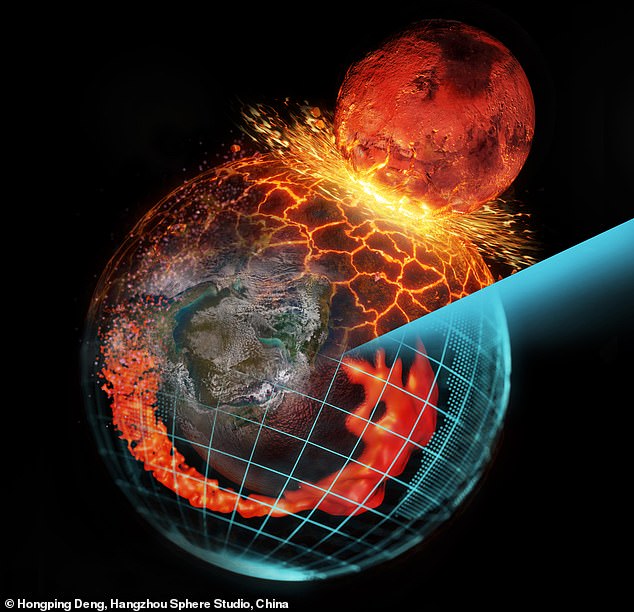Has the mystery of how the moon formed finally been solved? Scientists find new evidence our lunar satellite was created during a giant impact between Earth and a Mars-sized planet 4.5 billion years ago
>
It’s a mystery that has gripped humanity for hundreds of years – how exactly did our moon come to be?
Since the 1970s, astronomers have suspected that our natural satellite was created when a giant protoplanet called Theia hit the early Earth (Gaia).
However, the nature of this collision and what happened immediately afterward have been a matter of debate, with some scientists suggesting that it created a massive cloud of debris that coalesced into the Moon over time.
Now, new evidence has been uncovered supporting the impact theory 4.5 billion years ago, as well as revealing a rather surprising fact about our planet.
A new study says the collision not only created the Moon, but also buried traces of Theia deep in Earth’s mantle, which eventually helped create Hawaii and Iceland.

Discovery: Scientists have found new evidence that the Moon was created during a giant collision between Earth and a Mars-sized protoplanet called Theia 4.5 billion years ago. This also buried traces of Theia deep in the Earth’s mantle (as seen after the impact).

Theory: Experts believe the dense material sank to the lower region of Earth’s mantle, where it gathered together to form heavy blobs above our planet’s core that still exist today (shown in the center of the image of Earth).
Researchers led by the California Institute of Technology said that these traces from a protoplanet the size of Mars were thousands of miles across.
They believe the dense material sank to the lower region of Earth’s mantle, where it gathered together to form heavy blobs above our planet’s core that still exist today.
Scientists reached their conclusion with the help of computer simulations aimed at explaining why… A massive anomaly deep inside the Earth.
There are two regions at the base of our planet’s mantle that are unusual and different from the rest of the layer.
One, known as large low-velocity provinces (LLVPs), lies beneath the African tectonic plate and the other lies beneath the Pacific tectonic plate.
Its existence was confirmed when geologists found that seismic waves slowed significantly at a depth of 1,800 miles (2,900 kilometers) in the two regions, which is different from other parts of the Earth.
Scientists believe that the material in these LLVPs is between 2 and 3.5% denser than the surrounding mantle.
These regions are important because they played a major role in how the mantle evolved, which in turn would influence the formation of supercontinents and Earth’s tectonic plates.
However, how they appear remains largely a mystery.
Realizing the theory of moon formation, lead author Qian Yuan and his colleagues came up with the idea that LLVPs could have evolved from a small amount of Theyan material that entered Gaia’s lower mantle.
To support this, they asked Professor Hongping Ding, from the Shanghai Astronomical Observatory, to explore this idea with the help of his pioneering methods in computational fluid dynamics.
After performing a series of simulations, Professor Ding discovered that after the moon-forming impact, a large amount of Theian mantle material – about 2% of the Earth’s mass – entered Gaia’s lower mantle.

After performing a series of simulations, Professor Ding discovered that after the moon-forming impact, a large amount of Theian mantle material – about 2% of the Earth’s mass – entered Gaia’s lower mantle. This is shown in orange in the artist’s image above
He added that the impact appears to have been “the starting point of Earth’s geological evolution over 4.5 billion years.”
The researchers also calculated that this lunar rock-like material is likely iron-rich, making it denser than the surrounding Gaian material.
This, they said, is what caused it to sink to the bottom of the mantle and eventually form two LLVP regions that have remained stable despite 4.5 billion years of geological evolution.
He also points out that the Earth’s interior is not a “boring” uniform system, but is actually a mixture of materials that can be brought to the surface to form land masses like Hawaii and Iceland.
“Through careful analysis of a wide range of rock samples, combined with more accurate giant impact models and Earth evolution models, we can infer the physical composition and orbital dynamics of the primordial Earth, Gaia, and Theia,” said Dr. Yuan.
“This allows us to constrain the entire history of the formation of the inner solar system.”
Not only that, but because giant impacts are common at the end of a planet’s formation, scientists say similar variations in the mantle may also exist in the interiors of other planetary bodies in our solar system and beyond.
The new study was published in the journal nature.
(Tags for translation)dailymail
